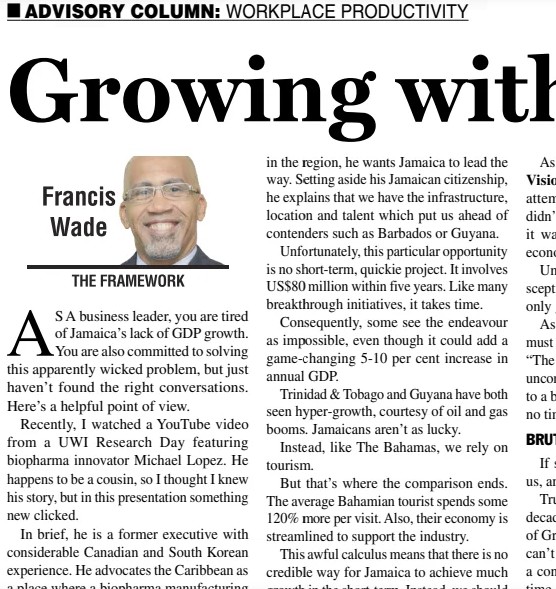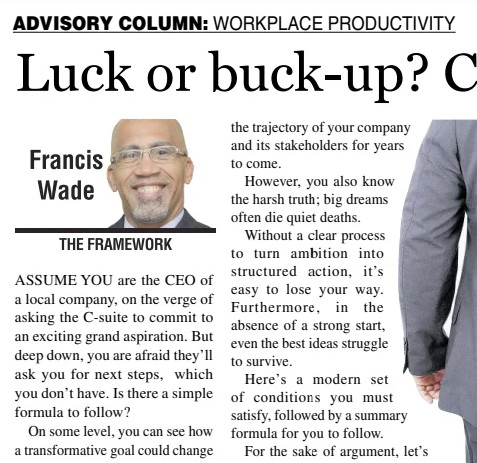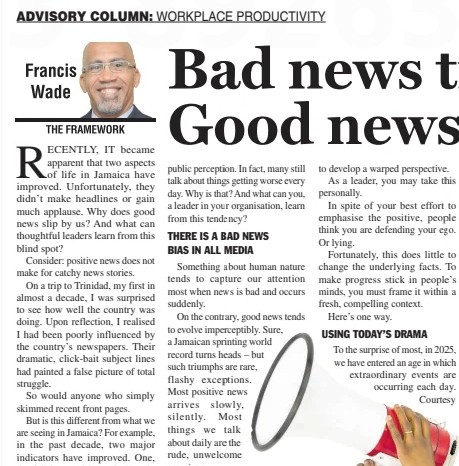As a business leader, you’re tired of hearing about countries with stagnant economies. Perhaps your own nation is among them — stuck in low-growth mode, with seemingly no way out. Yet, you’re committed to finding answers. You’re ready for bold ideas, not short-term gimmicks.
Here’s one worth your time.
A few weeks ago, I watched a YouTube video from a university research day featuring Michael Lopez, a BioPharma innovator with ties to Canada and South Korea. He’s also my cousin, so I thought I knew his backstory. But this presentation hit differently.
Lopez has a bold vision: establish a BioPharma manufacturing industry in the Caribbean. He’s not talking about theory — he’s proposing a proven model, grounded in global best practices. And while the facility could go anywhere in the region, he believes Jamaica is the natural leader. It has the infrastructure, location, and skilled talent pool to outcompete neighbours like Barbados or Guyana.
But this isn’t a weekend project. The investment? Around US$80 million over five years. The potential return? A sustainable 5–10% annual GDP boost. Not bad for a “wicked” problem — one that looks impossible until it’s solved.
Facing the Facts
Other Caribbean nations have had growth spurts, thanks to fossil fuels. Trinidad and Tobago and Guyana both tapped into oil and gas to ignite rapid development. Jamaica, on the other hand, leans heavily on tourism — and not especially well.
For example, the average tourist visiting the Bahamas spends about 120% more than one visiting Jamaica. And the Bahamian economy is far better structured to support the tourism sector end-to-end.
This hard truth makes one thing clear: there’s no quick win for Jamaica or countries like it. There’s no magic bullet. No five-year plan will cut it. What’s needed is a Grand Industrial Strategy — a long-term, focused commitment to economic transformation.
A Vision Beyond 2030
You might recall Jamaica’s Vision 2030
— a national roadmap launched to transition the country to developed status. While it didn’t dive deep into industrial policy, it offered a framework for change. But now, it’s become fashionable to be cynical about such visions.
That’s a mistake.
If we take a longer view — what Apple CEO Tim Cook calls “the long arc of time” — we may be closer to breakthrough than it appears. This is not the moment to give up. It’s the moment to double down.
Let’s look at four unavoidable truths, informed by history and grounded in realism.
Truth #1: Transformations Take Decades
Major economic wins don’t happen overnight. Consider the Jamaican company GraceKennedy and its “GK 2020” plan. It took 25 years of disciplined execution to turn vision into results. Real change takes long-term thinking — and staying the course.
Truth #2: Politics Can Get in the Way
As another election cycle looms, many countries face the same problem: political battles overshadow growth strategies. Even when elections are peaceful, short-term thinking often trumps long-term policy. That’s a structural challenge.
Truth #3: We Can Achieve Great Things Together
History shows we can come together to achieve national milestones — from winning independence to dramatically reducing debt-to-GDP ratios. When we align across sectors and silos, we move mountains.
Truth #4: Some Goals Must Transcend Politics
Big ideas — like a regional BioPharma industry — can’t be reduced to partisan talking points. Political leaders may be tempted to take credit, but nation-building requires collective ownership. No single party or figure should be at the centre.
If these truths resonate, then support those who aim to build cross-sector alliances — across political parties, businesses, civil society, churches, and everyday citizens. This collaborative approach is how Vision 2030 was born: through six years of engagement with thousands of Jamaicans from all walks of life.
It wasn’t perfect, but it created lasting alignment. Now we must take what we learned, let go of our cynicism, and aim higher.
Time to Build Again
As elections approach, we have a unique opportunity. Why not use this moment to begin drafting the next grand vision — one that spans 2030 to 2040 and beyond? A plan bigger than any single government, industry, or company.
BioPharma is just one example. But it shows what’s possible when we focus on innovation and long-term investment instead of short-term survival.
You may never see your name etched in history books. But like Dr. Martin Luther King Jr. said, “You may not get there with them.” Still, the sacrifice of planting the seeds — of thinking long-term, of putting country above self — could be the difference between stagnation and transformation.
You may not be called a hero.
But your effort as a business leader may just help rewrite the future.
Interested in more ideas like this explored in more detail? Visit https://longtermstrategy.info for more content.



